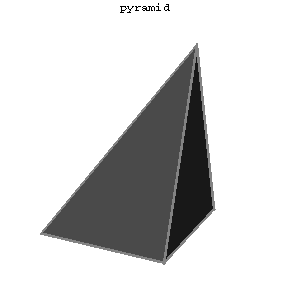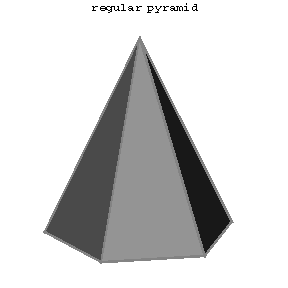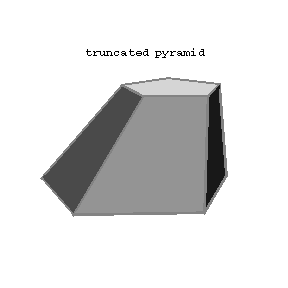Difference between revisions of "Pyramid"
(Importing text file) |
(TeX) |
||
| Line 1: | Line 1: | ||
| + | {{TEX|done}} | ||
A [[Polyhedron|polyhedron]] with as one of its faces a polygon (the base), while the other faces (the lateral ones) are triangles with a common vertex (the vertex of the pyramid) (see Fig. aand Fig. b). | A [[Polyhedron|polyhedron]] with as one of its faces a polygon (the base), while the other faces (the lateral ones) are triangles with a common vertex (the vertex of the pyramid) (see Fig. aand Fig. b). | ||
| Line 11: | Line 12: | ||
In accordance with the number of lateral faces, pyramids are divided into triangular, quadrilateral, etc. The segment of the perpendicular dropped from the vertex of the pyramid to the plane of the base is called the height of the pyramid, as is its length. The volume of a pyramid is given by | In accordance with the number of lateral faces, pyramids are divided into triangular, quadrilateral, etc. The segment of the perpendicular dropped from the vertex of the pyramid to the plane of the base is called the height of the pyramid, as is its length. The volume of a pyramid is given by | ||
| − | + | $$V=\frac13HS,$$ | |
| − | where | + | where $H$ is the height and $S$ is the area of the base. A pyramid is called regular (Fig. b) if the base is a regular polygon and the height passes through the centre of the base. The lateral faces of a regular pyramid are equal isosceles triangles; the height of each of these triangles is called the apothem of the regular pyramid (the apothem for the base of the pyramid is the projection of the pyramid's apothem on the plane of the base). |
On intersecting a pyramid with a plane parallel to the base, one gets two parts: a pyramid similar to the initial one and a truncated pyramid (Fig. c). | On intersecting a pyramid with a plane parallel to the base, one gets two parts: a pyramid similar to the initial one and a truncated pyramid (Fig. c). | ||
| Line 23: | Line 24: | ||
The polygon resulting from the intersection of the pyramid by the plane is called the upper base, while the base of the pyramid is called the lower base of the truncated pyramid. The distance between the cutting plane and the lower base is called the height of the truncated pyramid. The volume of a truncated pyramid is given by | The polygon resulting from the intersection of the pyramid by the plane is called the upper base, while the base of the pyramid is called the lower base of the truncated pyramid. The distance between the cutting plane and the lower base is called the height of the truncated pyramid. The volume of a truncated pyramid is given by | ||
| − | + | $$V=\frac13h(s+S+\sqrt{sS}),$$ | |
| − | where | + | where $h$ is the height and $s$ and $S$ are the areas of the bases. |
Latest revision as of 21:32, 11 April 2014
A polyhedron with as one of its faces a polygon (the base), while the other faces (the lateral ones) are triangles with a common vertex (the vertex of the pyramid) (see Fig. aand Fig. b).

Figure: p075930a

Figure: p075930b
In accordance with the number of lateral faces, pyramids are divided into triangular, quadrilateral, etc. The segment of the perpendicular dropped from the vertex of the pyramid to the plane of the base is called the height of the pyramid, as is its length. The volume of a pyramid is given by
$$V=\frac13HS,$$
where $H$ is the height and $S$ is the area of the base. A pyramid is called regular (Fig. b) if the base is a regular polygon and the height passes through the centre of the base. The lateral faces of a regular pyramid are equal isosceles triangles; the height of each of these triangles is called the apothem of the regular pyramid (the apothem for the base of the pyramid is the projection of the pyramid's apothem on the plane of the base).
On intersecting a pyramid with a plane parallel to the base, one gets two parts: a pyramid similar to the initial one and a truncated pyramid (Fig. c).

Figure: p075930c
The polygon resulting from the intersection of the pyramid by the plane is called the upper base, while the base of the pyramid is called the lower base of the truncated pyramid. The distance between the cutting plane and the lower base is called the height of the truncated pyramid. The volume of a truncated pyramid is given by
$$V=\frac13h(s+S+\sqrt{sS}),$$
where $h$ is the height and $s$ and $S$ are the areas of the bases.
Comments
For pyramids in arbitrary dimensions cf. [a1], [a2].
References
| [a1] | B. Grünbaum, "Convex polytopes" , Wiley (1967) |
| [a2] | P. McMullen, G.C. Shephard, "Convex polytopes and the upper bound conjecture" , Cambridge Univ. Press (1971) |
Pyramid. Encyclopedia of Mathematics. URL: http://encyclopediaofmath.org/index.php?title=Pyramid&oldid=11740